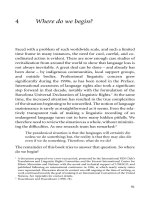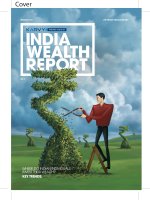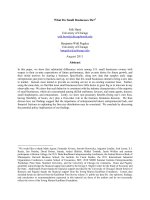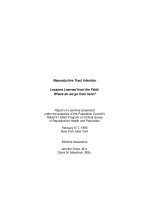PRIVATE WEALTH - WHERE DO INDIAN INDIVIDUALS INVEST THEIR WEALTH? pdf
Bạn đang xem bản rút gọn của tài liệu. Xem và tải ngay bản đầy đủ của tài liệu tại đây (7.89 MB, 37 trang )
WHERE DO INDIAN INDIVIDUALS
INVEST THEIR WEALTH?
KEY TRENDS.
DECEMBER 2011
VOL 2
FOR PRIVATE CIRCULATION ONLY
PRIVATE WEALTH
Cover
PRIVATE WEALTH
We are delighted to bring to you the second annual edition of the “India Wealth Report”.
Evidently, wealth in India continues to rise at an unprecedented rate, outperforming most
countries around the world. The happy confluence of high GDP growth and savings rate continue
to contribute to the same. With equity markets slowing down in FY11, the increase in wealth has
been lower than what we had forecast in our maiden edition. However, we believe that growth
will be back on track to keep up with the longer-term targets. Accordingly, we maintain that
wealth held by individuals in India will triple over the next five years!
In this second edition of the “India Wealth Report”
,
we have provided the latest financial-year
update on the status of wealth among Indian individuals. In addition, we have separately
attempted to bring about some fresh perspective on two very prominent asset classes in
India-real estate and gold. Through this Report, we enable you-the Indian HNI and the emerging
HNI-to understand the dynamics of the nation’s existing wealth across asset classes like equity,
debt and alternative assets. The Report will certainly enlighten you on where Indian individuals
have so far been parking their money. That way, you should be able to tell whether your portfolio
is favorably (or unfavorably) aligned to the overall trend, both in India and globally.
In that regard, the “India Wealth Report” offers comparative asset class-wise break-ups between
Indian and global wealth held by individuals. Such information will offer great insights for Indian
HNIs in that they will be able to comprehend where they have been under-invested or
over-invested, and, accordingly, make the necessary adjustments.
For instance, given that India’s individual wealth in alternative assets is 0.34% of our total
wealth (versus 6.2% globally), we believe that alternative assets will be a major investment
avenue in India over the next few years. The key premise of many alternative assets is a
single-product offering catering to multiple investment objectives. As long as we are clear about
our investment objectives, we can identify alternative avenues that will prove to be winners.
Moreover, we need not pick up all our learning from the West; instead, we can use our “glocal”
(combination of global initiatives and local dynamics) capabilities to develop smart alternative
investment products in India.
For a more detailed discussion on the contents of this Report, please feel free to drop me a line.
Happy Reading…Keep Growing.
Sunil Mishra
Chief Executive Officer
Karvy Private Wealth
FOREWORD
Executive Summary 3
Section 1: Global Wealth 7
Section 2: Current Indian Economic Scenario 8
Section 3: Individual Wealth in India 9
3.1 Direct Equity 9
3.2 Mutual Funds 10
3.3 Insurance 11
3.4 Fixed Deposits and Bonds 13
3.5 Savings Bank Deposits 16
3.6 Small Savings 17
3.7 Provident Fund 18
3.8 Alternative Assets 19
3.9 Total Wealth in India 23
Section 4: Individual Wealth - India versus Global 24
Section 5: Gold and Realty - An Overview 25
Section 6: Future of India’s Wealth 29
6.1 Financial Household Savings 29
6.2 Forecast of Individual Wealth 30
6.3 Key Trends 31
About Karvy Private Wealth 32
CONTENTS
1
Table 1: Asset-wise individual wealth in india
Table 2: Asset class-wise individual wealth in india
Table 3: Asset class-wise classification of global wealth
Table 4: Direct equity classification
Table 5: Mutual funds-Individual wealth based on underlying investment
Table 6: Insurance
Table 7: Fixed deposits & bonds-Individual wealth
Table 8: Fixed deposits-Individual wealth
Table 9: Bonds-Individual wealth
Table 10: Savings bank deposits-Individual wealth
Table 11: Small savings-Individual wealth
Table 12: Provident fund-Individual wealth
Table 13: Alternative assets-Individual wealth
Table 14: Individual wealth-India versus global based on asset class
Table 15: Financial household savings projections
Table 16: Individual wealth forecast
LIST OF TABLES
2
India is one of the fastest-growing economies in the
world. Over the last decade, both government and
private industry have endeavored to bring about an
environment conducive to growth. This is
increasingly reflected in better earnings and higher
disposable incomes for the working population,
particularly the middle class. Accordingly, the country’s domestic consumption story took off at a
blistering pace, thus significantly improving people’s standard of living, both rural and urban,
over the last decade.
The spectacular story of India’s economic growth has resonated strongly among investors around
the world. In fact, despite formidable headwinds in recent years, including the 2008 global
financial crisis, the subsequent Euro-zone debt impact, and the stubbornly high domestic
inflation, India continues to be one of the fastest-growing nations in the world. Needless to say,
we believe the next two decades belong to India, and the country is well on its way to become
the most attractive frontiers for international investors.
A wide range of better-regulated investment options have made its way into the financial
marketplace over the last decade. However, the sheer complexity of these options - in terms of
inherent risks, benefits and objectives - has got the average investor more confused than ever.
That said, investors today are far more educated than they were a decade ago. And given their
high savings rate, they are increasingly looking for guidance and investment advice to facilitate
their diverse goals. Moreover, as the coming decades play out for India, we believe that investors
will increasingly seek out financial planning and wealth management solutions in this complex
marketplace.
EXECUTIVE SUMMARY
3
Asset Amount (` cr.) Proportion (%)
Fixed deposits and bonds 26,76,878 30.95
Direct equity 25,76,317 29.78
Insurance 15,25,735 17.64
Savings deposits 6,16,917 7.13
Small savings 5,23,908 6.06
Provident fund 4,11,901 4.76
Mutual funds 2,88,543 3.34
Alternative assets 29,565 0.34
Total 86,49,764 100
TABLE 1: ASSET-WISE INDIVIDUAL WEALTH IN INDIA
The global High net-worth individual (HNI)
1
population and wealth growth returned to more stable
levels in 2010. During the year, the HNI population
rose 8.3% to 10.9 million
2
while HNI financial
wealth grew 9.7% to US$ 42.7 trillion
3
. Meanwhile,
the global population of ultra-HNIs
4
rose 10.2% to
1,03,000 and wealth by 11.5%
5
Estimated Individual Wealth in India
The total Individual Wealth in India is calculated by summing up the value of all investment assets
(see Table 1). In that regard, we have only considered the wealth held by ‘individuals’; we have not
included government and institutional holdings. Moreover, we have only considered ‘financial’
assets and not physical assets like real estate and gold. Accordingly, the total wealth in India held
by ‘individuals’ is estimated to be ` 86.5 lakh crore in FY11 (Financial Year ended March 2011).
Global Individual Wealth
1. HNIs are defined as those having an investable asset of US$ 1 million or more excluding primary residence, collectibles,
consumables, and consumer durables. • 2. World Wealth Report 2011, Page 5, Figure 1. Capgemini-Merrill Lynch Wealth
Management. • 3. World Wealth Report 2011, Page 5, Figure 2. Capgemini-Merrill Lynch Wealth Management. • 4. Ultra-HNIs
are defined as those having investable assets of US$30 million or more, excluding primary residence, collectibles, consumables,
and consumer durables. • 5. World Wealth Report 2011,Page 7.Capgemini-Merrill Lynch Wealth Management.
4
Fixed deposits have always been popular among risk-averse investors. Given the global economic
uncertainties and persistent high inflation in India, many individual investors made a shift towards
safer investment avenues like fixed deposits FY11, as against direct equity in FY10.
The HNI population in India rose by around 20.8%
6
in 2010, and their wealth is estimated to have
grown by more than 11%, to US$ 530 billion. India is one of the fastest-growing HNI segments in
the world, currently contributing approximately 1.2% to the global HNI wealth.
Table 2 highlights the risk-averse nature of Indian individuals. Investments in debt instruments
form a major part of the total Individual Wealth in India, with nearly 68% getting parked in this
asset class. Although investments in equity, constituting nearly 32%, have risen over the past
decade, the majority of investments by individuals in India are still in debt instruments. Alternative
assets, although a negligible portion of the total Individual Wealth in India, are increasingly
gaining popularity among HNI investors in the country, with investments in this asset class
contributing 0.34% to the total wealth of individuals.
In comparison, individual investors globally are less risk-averse than their counterparts in India.
A break up of Global Individual Wealth shows that equity accounts for nearly 41%, whereas debt
constitutes approximately 53%, and alternative assets, 6.2%.
Asset class Amount (` cr.) Proportion (%)
Equity 27,49,569 31.79
Debt 58,70,630 67.87
Alternative assets 29,565 0.34
Total 86,49,764 100.00
TABLE 2: ASSET CLASS -WISE INDIVIDUAL WEALTH IN INDIA
6. World Wealth Report 2011, Page 7, Figure 3. Capgemini-Merrill Lynch Wealth Management
5
• Total Individual Wealth in India is expected to nearly triple to ` 249 lakh crore by FY16 from
the current ` 86.5 lakh crore.
• Fixed deposits have regained popularity in FY11 to become the single-largest investment
class. These instruments are expected to continue to be the largest and preferred investment
class, at least in the next couple of years.
• Indian companies are becoming more mature, and with increasingly greater numbers getting
listed, Individual Wealth in equities is expected to reach 37% in India in FY16, against
30% in FY11.
• As retirement benefits become more limited for the newer generation of government
employees, they will begin to increasingly focus on retirement planning. As awareness
increases, more investments will be channelised into pension funds and retirement benefits.
• Alternative assets - including structured products, private equity and venture capital funds,
gold ETFs, and realty, film and art funds - are expected to grow at a rapid pace of 100%
per annum.
• Although the average investment size is larger, structured products and highyield debt will
remain popular among HNIs as these are relatively safe in terms of principal protection.
• Over the next five years, we will also see a rise in insurance investments as private
companies become more evolved.
Key Trends
6
SECTION 1: GLOBAL WEALTH
The global population of HNIs rose 8.3% Y/Y
to 10.9 million in 2010. During the year, the
global financial wealth of HNIs grew 9.7% to
US$ 42.7 trillion (including real estate).
Table 3 shows the asset class-wise
classification of Global Wealth (excluding real
estate). The HNI population grew the fastest in
the Asia-Pacific region due to faster-growing
economies like China, India and Australia. The
HNI population in the Asia Pacific rose 9.7%
to 3.3 million in 2010 and the financial wealth
of these HNIs grew 12.1% to US$ 10.8
trillion. Meanwhile, the wealth held by HNIs in
India grew 11%. Accordingly, the Asia-Pacific
HNI population has become the second-
largest in the world. It has overtaken Europe
(3.1 million HNIs in 2010) and is close on
the heels of North America (3.4 million)
7
.
7. Asia-Pacific Wealth Report 2011, Page 4. Capgemini-Merrill Lynch Wealth Management
TABLE 3: ASSET CLASS-WISE CLASSIFICATION OF GLOBAL WEALTH
Asset class Amount (US$ trillion) Proportion (%)
Equity 14.09 40.7
Debt 18.36 53.1
Alternative assets 2.14 6.2
7
SECTION 2: CURRENT INDIAN
ECONOMIC SCENARIO
8. RBI • 9,10,11. Economic Survey 2010-11
We believe that it is now India’s turn to gain
from the innovativeness of its new-age
entrepreneurs, and the rising incomes and
savings of its working population. That said,
high inflation and borrowing costs are
currently slowing down the nation’s GDP
growth, which is expected to be 7.6%
8
in
FY12 (financial year ended March 2012).
India’s GDP growth had reverted to the
high-growth trajectory in FY11. This was
following a period of moderation in the
preceding two years in the face of a global
economic slowdown, triggered by the 2008
financial crisis. The GDP growth in FY11 came
in at 8.5%
9
, after having declined to 6.7% in
FY09 and 7.4% in FY10
10
. The FY11 GDP
growth reflects a rebound in agriculture and
sustained levels of activity in industry and
services; the nation’s GDP (at current market
prices) has come in at ` 79 lakh crore
11
.
Traditionally, India enjoys a very high savings
rate. It was approximately 34% in FY11, of
which financial household savings were
around 11.8%. From a global perspective,
between 1959 and 2010, people in developed
countries like the US saved on average 7% of
their disposable income. On the other hand,
the average savings rate in India, which was
about 20-25% through the 1970s and
1980s, is now a phenomenal 30-35%. More
importantly, India’s savings rate is expected to
stabilise at 35% levels going forward owing
to high economic growth.
N
DIAN
gain
a
n
d
sai
d
,
P
i
n
2)
Trad
it
io
na
ll
y
Ind
ia
e
nj
oy
s
a
ve
ry
h
ig
h
sa
vi
ng
s
8
The total wealth held by individuals in India is
estimated at ` 86.5 lakh crore in FY11. It is
derived by summing up all asset classes,
broadly classified into equity, debt and
alternative assets. We make an effort to
estimate the Individual Wealth in India based
on investment avenues and financial assets
available in the country.
The following investment avenues and
financial assets have been considered to
estimate Individual Wealth:
• Direct equity
• Mutual funds
• Insurance
• Provident funds
• Fixed deposits & bonds
• Savings bank deposits
• Small savings
• Alternative assets
For the purpose of this Report, physical assets
like gold and real estate have been excluded.
3.1 Direct Equity
Over the last decade, investor preferences have
changed in India, with more people willing to
invest in high-risk, high-return assets like
SECTION 3: INDIVIDUAL
WEALTH IN INDIA
direct equity, to try and earn better returns. The
equity market witnessed spectacular growth in
the phenomenal four-year bull run that
culminated in 2007. In the recession-hit years
of FY09, however, markets declined sharply
by nearly 40% to ` 29 lakh crore. But it made
a huge comeback in FY10, when market
capitalisation more than doubled to reach
` 60 lakh crore
12
, as investors showed greater
confidence in equity investments.
Meanwhile, growth has slowed down
drastically in 2011. The overall market
capitalisation of direct equity in FY11 came in
at ` 67 lakh crore, a gain of 11.6% Y/Y
13
.
Direct equity can be broadly categorised into
promoter holdings (33%), institutions (48%)
and retail investors (19%). Promoter holdings
here would contain all individuals,
government and corporate holdings. In 2010,
12, 13. SEBI
9
3.2 Mutual Funds
The Indian mutual fund industry saw rapid
growth for some years, driven by favorable
economic and demographic factors. These
included favorable stock markets, higher
disposable incomes and savings, diverse
choices of personal finance products,
convenience of investing, high-quality service
delivery, well-regulated, entry of
professionally-managed asset management
companies (AMCs), and aggressive marketing
coupled with proactive investor education by
AMCs. However, after years of sustained
growth, there was a 17% decline in FY09
assets under management (AUM) in the
backdrop of the global financial turmoil,
adversely impacting industry revenue and
profitability.
The mutual fund industry received another
major setback in 2009 when entry loads were
abolished. Consequently, many mutual fund
distributors shifted focus to other financial
products which offered better commissions.
The poor sentiment in the markets has not
helped either. Accordingly, there has been an
industry slowdown, and the sector continues
to be hugely underpenetrated in India.
Ironically, in developed markets, mutual fund
14. World Wealth Report 2011,Page 8. Capgemini-Merrill Lynch Wealth Management
the equity market capitalisation globally had
risen by 18%
14
.
In regard to Individual Wealth, direct
equity is the second-largest contributor
among asset classes, at 29.78%, with
total wealth held by individuals in direct
equity at
`
25.76 lakh crore.
For the purpose of this Report, only individual
direct equity investments have been
considered. The growth in individual equity
investments has been lower than the increase
in total market capitalisation. This indicates
individual investors’ reduced confidence in the
Indian stock markets.
Investor Market capitalisation % Amount (` cr.)
Promoter holdings 32.92% 22,06,501
Institutions 47.95% 32,13,904
Retail investors 19.13% 12,82,210
Total 100.00% 67,02,616
TABLE 4: DIRECT EQUITY CLASSIFICATION
10
investments constitute a significant proportion
of one’s portfolio.
The total mutual fund AUM in India declined to
` 5.97 lakh crore as of March 2011. The
AUM of equity-oriented mutual funds has
declined in FY11 whereas debt-oriented
mutual funds’ AUM has risen more than 20%
during the same period.
Mutual funds constitute 3.34% of total
Individual Wealth in FY11,
and is lower
than in FY10 when it was 3.8%. For the
purpose of this Report, only HNI and retail MF
investments have been considered, while
corporate and institutional investments have
been excluded. Hence, total wealth from
mutual funds with individual investors stands
at ` 2.88 lakh crore in FY11.
3.3 Insurance
The total wealth held by individuals in India as
insurance assets comprise life insurance,
employees’ pension fund (EPF) and
employees’ deposit-linked insurance fund. The
reforms in the sector have not only brought
about robust competition in the marketplace,
but customers today have a vast range of
products and solutions to choose from to cater
Asset class Amount (` cr.)
Equity 1,73,252
Debt 1,15,291
Total 2,88,543
TABLE 5: MUTUAL FUNDS - INDIVIDUAL WEALTH BASED ON UNDERLYING INVESTMENT
Figure 1: AUM of Mutual Funds
Mar 06 Mar 07 Mar 08 Mar 09 Mar 10 Mar 11
700000
` in crores
600000
500000
400000
300000
200000
100000
0 Year
11
to their every need and goal. Moreover,
insurers today are spending time and money
to increasingly focus on product R&D and to
understand market needs. That said, despite
the entry of the private sector more than a
decade back, insurance penetration still
remains rather low today. However, this is
likely to change in the coming years when
private players come of age.
Life insurance is the biggest segment, with 23
life insurers having a combined AUM of
` 13.97 lakh crore in FY11. Clearly,
individuals in India, especially in urban and
semi-urban areas where insurance penetration
is higher, give importance to safeguarding
their own and family’s future. Among life
insurers, the public sector Life Insurance
Corporation of India (LIC) still enjoys the
highest market share, with more than 70% of
the total sum assured.
In FY11, employees pension fund assets
amounted to ` 1,19,800 crore and the assets
in employees deposit-linked insurance fund
aggregated ` 8,267 crore.
TABLE 6: INSURANCE
Asset type Amount (` cr.)
Life insurance 13,97,667
Employees pension fund 1,19,800
15
Employees deposit-linked insurance fund 8,267
16
Total 15,25,734
7.85% 0.54%
91.61%
Figure 2: Composition of Insurance Assets
Life Insurance
Employees Pension Fund
Employees Deposit Linked Insurance Fund
15,16. EPFO Annual Report
12
After fixed deposits and equity, insurance is the third-most popular asset class among individual
investors in India, with many products and financial solutions giving them the benefit of insurance
(risk management), investment and tax planning, in that order.
At
`
15.25 lakh crore, insurance assets account for 17.64% of the total Individual
Wealth in FY11.
As the penetration of insurance companies rise and as retirement benefits become more limited for
the newer generation of government employees, we are likely to see an increase in wealth held by
individuals in insurance assets. Meanwhile, the regulator - Insurance Regulatory and
Development Authority (IRDA) - is set to change the rules for pension plans. This could help the
industry to recoup business volumes, which had fallen sharply late last year after the regulator
had imposed stringent guidelines.
Figure 3: Assets in Insurance
Mar 08 Mar 09 Mar 10 Mar 11
2000000
1500000
1000000
500000
0
`
in crores
Years
TABLE 7: FIXED DEPOSITS & BONDS - INDIVIDUAL WEALTH
Asset Amount (` cr.)
Fixed deposits 26,70,008
Bonds 6,870
Total 26,76,878
3.4 Fixed Deposits & Bonds
Fixed deposits allow investors to park their savings in a bank, financial institution or a company
for a particular timeframe. Also referred to as term deposits, these fixed-income instruments earn a
higher return compared to the interest rates offered by a savings account. Fixed deposits are one
of the
safest investment options available to investors. It typically attracts risk-averse investors who
want to park their money for the long term at relatively higher interest rates. Moreover, banks usually
offer senior citizens a small mark-up on prevailing rates. Fixed deposits are available for different
time periods, ranging from a few days to many years.
13
17,18,19. RBI
(1) Fixed Deposits: These fixed-income
instruments can be classified into: (a) Bank
fixed deposits; (b) Corporate fixed deposits;
(c) Fixed deposits with non-banking finance
companies (NBFCs); and (d) Fixed deposits
with residuary non-banking companies
(RNBCs).
(a) Bank Fixed Deposits: Also referred to
as FDs, these are classified into: (a)
Scheduled commercial bank FDs; and (b)
Co-operative bank FDs. One of the most
preferred options for investors, bank FDs have
returned to a high-growth trajectory after
deposit growth slowed down to about 16% in
FY10. These deposits have been growing at a
compounded rate of more than 20% from the
last 4 years. As of March 2011, the total bank
FDs in India amount to ` 48.8 lakh crore, of
which ` 25.7 lakh crore is estimated to be
with individuals. Of the total FDs, commercial
banks account for more than 97%, at ` 47.4
lakh crore
17
.
(b) Corporate Fixed Deposits: Many
companies, including reputed industrial
houses, accept deposits from investors to meet
funding requirements. Held for a particular
time period, these deposits usually fetch
higher interest rate than traditional bank FDs.
However, many a time the risk involved is
also higher. The AUM of corporate fixed
deposits in India is around ` 73,500 crore.
These deposits have grown by more than
22% in FY11.
(c) NBFC Fixed Deposits: The NBFCs
registered with the RBI are classified into asset
finance companies, investment companies
and loan companies. These may be further
categorised into those that accept deposits
and those that do not. The NBFCs are allowed
to accept/renew public deposits for minimum
12 months and maximum 60 months.
However, due to tightening of capital norms,
many NBFCs have been forced to reduce their
assets. The wealth held by individuals in these
deposits amount to ` 3367 crore
18
.
(d) RNBC Fixed Deposits: RNBCs are also
registered as an NBFC with the RBI. The
principal business of these companies is to
accept deposits under any scheme or
arrangement as long as it is unrelated to
investment, asset financing and loans. The
functioning of RNBCs is different from those of
other NBFCs in terms of method of deposit
mobilisation and deployment of depositors’
funds. The total RNBC FD assets amount to
around ` 21,280 crore
19
.
14
(2) Bonds: These debt instruments can be
classified into PSU bonds and corporate
bonds.
a) PSU Bonds: Issued by various public
sector undertakings (PSU), the total AUM of
PSU bonds is ` 1,46,292 crore
20
. These
include both public bond
issues and privately
placed bonds, and include taxable and tax-free
bonds. The issue of PSU bonds, particularly
taxable bonds, more than doubled in FY10 and
there was a significant uptrend in FY11.
The estimated Individual Wealth in these
bonds is ` 2,445 crore.
b) Corporate Bonds: Non-PSU companies
also issue bonds to institutional and retail
investors. In FY11, there were a few big
corporate bond issues, leading to greater
investment by individual investors in these
bonds. The estimated amount invested in
these bonds by individual investors is
` 4,425 crore.
Figure 4: Distribution of Fixed Deposits
Bank FDs
Corporate FDs
NBFC FDs
RNBC FDs
96.32%
2.75%
0.13%
0.80%
TABLE 8: FIXED DEPOSITS - INDIVIDUAL WEALTH
FD types Amount (` cr.)
Bank FDs 25,71,873
Corporate FDs 73,488
NBFC FDs 3,367
RNBC FDs 21,280
Total 26,70,008
20. RBI
15
there is little (or no) penalty on withdrawals
prior to the maturity date. Meanwhile, with the
recent deregulation of the savings bank
deposit interest rate, we may see more liquid
money coming into savings deposits in the
coming years.
Savings deposits are popular, constituting a
considerable portion of the total deposits of
scheduled commercial banks. A savings
accounts can be opened in: (a) Scheduled
commercial banks; and (b) Scheduled
co-operative banks.
The total savings
bank deposits held by individuals
amount to
`
6.17 lakh crore
21
,
constituting 7.13% of total Individual
Wealth.
Bond types Amount (` cr.)
PSU bonds 2,445
Corporate bonds 4,425
Total 6,870
TABLE 9: BONDS - INDIVIDUAL WEALTH
21. RBI
T
ogether, fixed deposits & bonds
comprise 30.95% of the total Individual
Wealth in India, making it the largest
contributor among all asset classes.
3.5 Savings Bank Deposits
One of the most convenient options for
individuals, savings bank deposits offer high
liquidity and low risk. Deposits in scheduled
banks are quite safe due to RBI regulations.
These deposits declined 13% in FY11. The fall
can be attributed to the very low interest rates
offered on these deposits. Given the high
interest-rate scenario, investors preferred
parking their money in other avenues like FDs
that offer high interest rates and nowadays,
Bank Amount (` cr.)
Commercial banks 6,02,610
Co-operative banks 14,307
Total 6,16,917
TABLE 10: SAVINGS BANK DEPOSITS - INDIVIDUAL WEALTH
16
3.6 Small Savings
Individuals have been traditionally investing in
different post office small-savings schemes,
such as Post Office Monthly Income Scheme
(POMIS), Post Office Time Deposits, National
Savings Certificate (NSC), Kisan Vikas Patra
(KVP), Savings Accounts, and so on. The total
amount invested by individuals in such post
office small-savings schemes
is
`
5.24 Lakh
crore, contributing around 6.06% to the
total wealth held by individuals in India.
Post office public provident funds are not
considered under small savings as it has been
included under provident fund (”see next
section”). Overall, investments in small
savings have been quite stagnant over the
years. It rose at a negligible pace in FY10 after
declining for two consecutive years. However,
certain schemes like Senior Citizens Saving
Scheme, Post Office Recurring Deposit
account, and Post Office Savings Bank
Accounts have shown significant growth. That
is because, apart from offering a decent
Small savings schemes Amount (` cr.) Change (%)
(FY11 v/s FY10)
POMIS 1,77,756.2 (0.97)
KVP 1,48,071.3 0.38
Post office recurring 71,477.2 9.84
deposit account
NSC VIII issue 54,158.2 (2.08)
Post office savings bank account 24,771.4 9.17
Senior Citizens Savings Scheme 23,048.2 11.61
Post office time deposit account 21,749.9 (17.19)
Deposit scheme for retiring 1,244.0 0
government employees 1989 /
retiring employees of public sector
Indira Vikas Patra 1,097.2 6.42
National Savings Scheme 1992 534.25 (5.44)
Total 5,23,907.9 0.91
TABLE 11: SMALL SAVINGS - INDIVIDUAL WEALTH
17
interest rate, these are key investment avenues
in rural India where banking is still not so
popular. These schemes are not effectively
marketed by the government, and with other
safe options like bank FDs offering higher
interest rates, investments in these instruments
are not as attractive as it was earlier when the
banking system was not so evolved.
3.7 Provident Fund
Provident fund is a social security scheme as
well as a tax-saving instrument. Traditionally,
it has been used as a retirement planning tool
by individual investors in India. Provident
funds can be divided into Employees’
Provident Fund (EPF) and Public Provident
Fund (PPFs).
An EPF is a defined-contribution plan for the
Indian workforce, administered by the
Employees’ Provident Fund Organisation
(EPFO), whereby the employee puts in a
certain share of his basic pay in the Fund and
the employer must also compulsorily
contribute in a similar amount. PPF, on the
other hand, is a voluntary scheme for
Provident fund types Amount (` cr.)
EPF 2,95,651
PPF with banks 90,374
PPF with post offices 25,876
Total 4,11,901
TABLE 12: PROVIDENT FUND - INDIVIDUAL WEALTH
21.94%
6.28%
Figure 6: Distribution of Provident Fund
Employee Provident Fund
Public Provident Fund with Banks
Public Provident Fund with Post Offices
71.78%
18
individuals, whereby a PPF account can be
opened with a post office or through various
nationalised banks across the country.
The total provident fund assets in FY11
aggregated
`
4.12 lakh crore,
constituting 4.76% of the total Individual
Wealth in India.
Between the two, EPFs
enjoy a bigger market share, with total wealth
invested by individuals amounting to ` 2.95
lakh crore. The wealth by individuals in PPFs
is estimated to be around ` 1.16 lakh crore
22
,
of which banks hold nearly 78% of the PPF
assets, at ` 90,374 crores. Clearly, investors
value these social security schemes for their
post-retirement needs.
The wealth held by individuals in the EPF has
been rising consistently, driven by an
increasing number of establishments coming
under its ambit every year, apart from rising
employee strength, attractive interest rates and
lack of investment opportunities in the
prevailing uncertainty. As the India story
continues on its growth trajectory, we expect
investments to rise further in the coming years.
3.8 Alternative Assets
These assets broadly differ from a traditional
investment product. Statistically; these
investments often provide returns that have a
low or negative correlation to traditional
investments like common equity shares or
fixed-income instruments. For instance, if
equity markets move in a particular direction,
an alternative asset may not necessarily
follow suit. Thus, given the unconventional
nature of these investments, alternative assets
help to diversify and reduce the overall
portfolio risk.
Alternative investments are quite in vogue
among HNI investors globally; they are likely
to allocate 5-10% of their investment portfolio
into these products
23
. Globally, alternative
assets are expected to constitute nearly 8% of
the HNI wealth in 2012
24
. These investments
accounted for as much as 10% of HNIs’
financial assets in 2006, but had fallen to as
low as 6% by 2009 due to the economic
slowdown.
In India, investment in alternative assets has
increased significantly in FY11, with investors’
rising confidence in this relatively newer class
of assets. The most popular alternative asset
is the structured product (equity- and
gold-linked debentures), constituting nearly
72% of the total wealth in this asset class.
Already, structured products, private equity,
gold ETFs and real estate funds have grown
significantly in FY11. Going forward, we
22. Times of India • 23. Economic Times
24. World Wealth Report 2011, Page 17, Figure 10. Capgemini-Merrill Lynch Wealth Management
19
believe that HNI investors will continue to
show robust interest in this asset class. In a
nutshell, alternative assets, which
constitute
0.34% of Individual Wealth in India, are
expected to grow at a phenomenal rate
of 100%.
(1) Structured Products: A structured
product is a market linked investment that
facilitates “highly customised” risk-return
objectives. It is generally a pre-packaged
investment strategy based on derivatives,
wherein the underlying instrument can be a
single security or a basket of securities,
including equities, indices, commodities, debt
issuances, foreign currencies or swaps.
In India, structured products gained popularity
in 2006 and 2007 but then faded in the
market crash of 2008. There has been a
resurgence since then, making these one of
the most popular products in FY11. Although
the average investment size is larger,
structured products remain popular among HNI
investors. That is because it is designed to be
relatively safe avenue in that it ensures
principal protection in these troubled times. In
India, mostly equity- and gold-linked
structured products are sold to HNIs.
Equity-linked Debentures:
Here, a part of the
capital is invested in debt while the remaining
is linked to equity markets through a basket of
stocks or an index. The debt portion ensures
that the capital is protected, while the equity
portion facilitates participation in the event of
upside. Through this product, the investor
actually gets exposure to equity without
actually owning it. These debentures often
have a cap on return generated from the
equity upside. Equity-linked debentures made
a significant comeback in FY11. The total
assets in equity-linked debentures is estimated
to be around ` 21,267 crore, or a rise of
about 21% Y/Y.
Gold-linked Debentures:
A gold-linked
debenture is a structured product that comes
with a pre-packaged investment strategy
based on the underlying gold price. This
product also typically offers principal
protection if held until maturity. At maturity, the
payout is the original principal and any price
appreciation from the underlying gold asset.
The assets in gold-linked debentures is
estimated to be ` 120 crore.
20
25.SEBI • 26.AMFI
(2) Private Equity / Venture Capital
Funds:
Private equity funds typically make
investments in companies not listed on the
public stock exchanges. These offer
high-return opportunities due to their access to
dynamic, privately-held companies and their
ability to create value in them. In India, private
equity has gained significance over the years
in that they invest in smaller companies and
exit when these gain in scale and size, often at
a hefty premium to their investment value. The
assets in these funds are worth ` 14,847
crore
25
, and individual investments are
estimated to be around ` 2,970 crore, or
approximately 100% higher than last year.
(3) Gold ETFs: Gold ETF (GETF) is an
exchange-traded fund, wherein units can be
bought and sold on real-time basis on major
stock exchanges. Typically managed by a
mutual fund, units are issued to investors, who
can then participate and benefit from the
movement of gold prices. The benchmark used
by GETFs in India is London Gold, and the
fund house backs the value of the outstanding
gold units in the GETF by purchasing large
quantities of the yellow metal in physical form
and storing it. As on March 31, 2011,
investments in GETFs amounted to ` 2,447
crore
26
, an increase of 150% Y/Y.
GETFs have gained popularity in recent times
due to a variety of reasons. First, given the
global uncertainty playing out, gold has
become a safe-haven for investors. Secondly,
the shining metal is the only asset class on a
secular bull trend over the last 10 years.
Thirdly, advisors and planners are
increasingly promoting gold as an essential
investment asset class for diversification in
every portfolio. Finally, GETFs offer ease and
convenience of investing without the hassle of
buying or storing physical gold.
21
27,28.SEBI • 29.The Art trust
(4) Real Estate Funds: A real estate fund is
a professionally managed portfolio of
diversified real estate holdings. Here the
investor essentially makes investments in the
schemes of concerned firms, which, in turn,
invests the money in upcoming or ongoing
real estate projects. The return generated from
building and selling (or leasing) the projects
are the gains that accrue to investors. As of
March 2011, the assets in real estate funds
are estimated to have jumped nearly 100% to
` 10,220 crore
27
. For the same period,
individual investments is estimated to have
touched ` 2,044 crore.
5) Film Funds: These are funds that invest in
the production and marketing of films. The
Indian film industry is considered by many to
be recession-proof. Film funds set up a
special-purpose vehicle (SPV) to fund film
projects. The revenues from the project are
distributed among investors, and the return is
dependent on the success of the films. These
funds have become quite popular in India,
with many funds having been launched in the
last few years. Moreover, even some
production houses are planning to start their
own film funds. The total wealth in film funds
is ` 907 crore
28
, of which individual wealth is
estimated to be about ` 453 crore. It has
risen by 50% over the previous years.
(6) Art Funds: Globally, art funds are
popular as an alternative investment class for
HNIs. In India, these funds have started
gaining some ground over the last few years.
Those who are keen to invest in art can make
investments through art funds, thus
diversifying their investment portfolio. Artworks
are typically bought through exhibitions or
directly from the art collectors. The profit
generated from the sale of these artworks is
distributed among the investors. The
investments held by Individuals in these funds
has increased by 10.46% to ` 264 crores
29
in FY11.
TABLE 13: ALTERNATIVE ASSETS - INDIVIDUAL WEALTH
Asset type Amount (` cr.)
Structured products 21,387
Private equity 2,970
Gold ETFs 2,447
Real estate funds 2,044
Film funds 453
Art funds 264
Total 29,565
22









